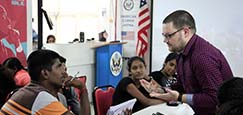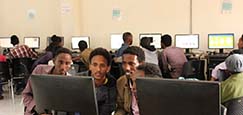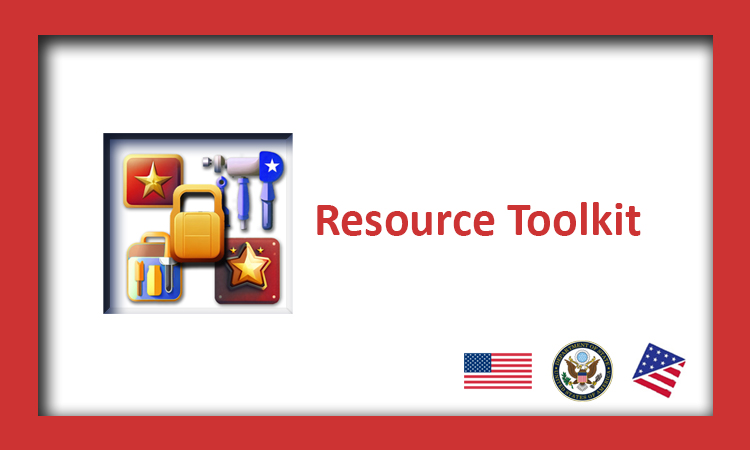FOOD SECURITY
PROGRAM TOOLKIT FOR AMERICAN SPACES
This program toolkit is designed for programming at American Spaces to define food security, identify food insecurity causes, outline U.S. government initiatives, and explore strategies for individuals to improve global food security.

U.S. Government Initiatives and Biotechnology
WHAT IS FOOD SECURITY?
Food security refers to the condition in which all people have reliable access to sufficient safe and nutritious food that meets their dietary needs and food preferences for an active and healthy lifestyle. Food security relies on four essential elements: availability, having enough food consistently available; accessibility, ensuring economic and physical access to food; utilization, guaranteeing its nutritional quality and safety; and stability, maintaining food system reliability even during disruptions.
CAUSES OF FOOD INSECURITY
Conflict: Armed conflicts and political instability disrupt food production, distribution, and access, leading to crop destruction, displacement, and severe food shortages.
Climate Change: Climate change, with extreme weather events like droughts and floods, harms agriculture by reducing crop yields and water availability for food production.
Economic Shocks: Economic challenges, including high food prices and crises, limit people’s ability to afford food, raising food insecurity concerns.
Poverty: Poverty is both a cause and consequence of food insecurity, with impoverished individuals lacking access to nutritious food and falling into cycles of hunger and malnutrition.
Natural Disasters: Natural events, such as earthquakes and hurricanes, disrupt agriculture, causing immediate food shortages and long-term challenges in rebuilding food systems.
Inequalities: Socioeconomic disparities limit vulnerable populations’ access to nutritious food, exacerbating food insecurity due to unequal access to resources and opportunities.
LESSON PLANS
Ending hunger | World Food Programme – This article by the World Food Programme discusses the causes of global food insecurity and outlines their efforts to address the underlying issues.
HungerMap LIVE – The HungerMap shares data on food security, weather, population size, conflict, hazards, nutrition, and macroeconomic factors to track and predict food security in near real time.
Food Security Game – This Peace Corps-developed lesson plan includes a group card game designed to educate participants about the factors that influence people’s level of food security.
Global Food Security | National Agriculture in the Classroom – This lesson plan includes activities, articles, videos, and interactives that educate participants about the causes of food insecurity, potential solutions for world hunger, and the impact of population growth on current food supplies.
Lesson Plan Broken Breadbasket: Food Security in Ukraine – Harvard University’s lesson plan incorporates narrative readings and graphs to instruct participants about the factors contributing to food security risks in Ukraine.
What you can do
#StopTheWaste | World Food Programme
Get Involved | World Food Programme
Make an Impact | The Hunger Project
Host an Oxfam Hunger Banquet® | Oxfam
How You Can Help | Action Against Hunger
Create Your Own Fundraiser | Action Against Hunger
Ways to Partner with The Global FoodBanking Network
The Cartagena Protocol on Biosafety
The Cartagena Protocol on Biosafety
FOOD INSECURITY SOLUTIONS
U.S. Government Global Food Security Strategy 2022-2026
The Global Food Security Strategy is designed to assist vulnerable populations worldwide in attaining food security. It consists of several key programs, with the Feed the Future initiative at its core, aimed at boosting agricultural productivity, raising farmers’ incomes, and enhancing access to nutritious food in developing nations. Additionally, the strategy includes the Global Food Security Response program, which delivers emergency aid during food crises and conflicts. Furthermore, the strategy places a strong emphasis on sustainable agriculture and nutrition, ensuring long-term food security and resilience against global challenges such as climate change.
Biotechnology
Biotechnology plays a pivotal role in enhancing food security by providing innovative solutions to agricultural challenges. It involves the application of genetic engineering, molecular biology, and other advanced techniques to develop crops that are more resilient to pests, diseases, and environmental stressors. Genetically modified (GM) crops, for example, can exhibit increased yields and nutritional content, which helps address food shortages in many parts of the world. Biotechnology also enables the production of drought-resistant or salt-tolerant crops, contributing to more sustainable agriculture. Moreover, biotechnological advancements are crucial in developing new varieties of crops that can adapt to changing climate conditions, ultimately supporting global food security efforts.
WHAT CAN YOU DO?
Reduce Food Waste: Minimize food waste by planning meals, purchasing only what you need, and properly storing leftovers to ensure resources are used efficiently and not wasted.
Advocate for Policy Change: Engage in advocacy efforts to influence policies that address food security and nutrition, advocating for improvements that enhance access to nutritious food for underserved communities.
Volunteer and Donate: Contribute your time, financial resources, or food items to local food banks, shelters, and organizations working to combat food insecurity, making a direct impact on those in need.
Support Local Food Initiatives: Back locally produced foods and farmers’ markets, and participate in community initiatives that bolster regional agriculture, strengthening local food systems and accessibility.
Educate Yourself and Others: Increase your knowledge of global and local food security issues, and share information with your network to raise awareness and encourage collective action.
DISCUSSION QUESTIONS
- How would you define food security, and why is it essential for individuals and communities?
- What are the main factors that contribute to food insecurity in different regions of the world?
- How does food security impact individuals and communities, both in terms of physical health and overall well-being?
- What are some specific government initiatives or policies in the United States aimed at addressing food insecurity?
- What can individuals do to contribute to resolving food insecurity in their local communities or on a global scale?
The views expressed in these links and resources do not necessarily reflect those of the U.S. government.
Updated December 2025









